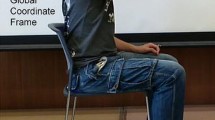Abstract
Various models have been proposed in the literature to explain the control of human arm movements. To make a quantitative comparison between the predictions of various models, we tested subjects for movements to targets on a vertical screen in various conditions. Subjects were asked to move directly from one target to another, or to move by a via-point, at various movement velocities and in a condition with a weight of 0.6 kg attached to the forearm. This set of experimental data was used for comparison with the predictions by various posture-based and trajectory-based models on 3-D movement planning and control. Small but significant effects of starting position and path towards the target were found on the torsion of the arm at the end of the movement. No effects of movement velocity and weight attached to the forearm were found. The experimental results differed significantly from the predictions by any of the models considered. Of the models considered, Donders’ law best predicts the experimental data. Our data indicate that future tests of models for motor control (1) should compare the predictions of not just one, but several models to a data set, and (2) should include not only planar, but rather 3-D movements in such a comparison.







Similar content being viewed by others
References
Desmurget M, Prablanc C (1997) Postural control of three-dimensional prehension movements. J Neurophysiol 77:452–464
Desmurget M, Prablanc C, Rosetti Y, Arzi M, Paulignan Y, Urquizar C, Mignot JC (1995) Postural and synergic control of 3-dimensional movements of reaching and grasping. J Neurophysiol 74:905–910
Desmurget M, Grea H, Prablanc C (1998) Final posture of the upper limb depends on the initial position of the hand during prehension movements. Exp Brain Res 119:511–516
Feldman AG, Levin MF (1995) Positional frames of reference in motor control: origin and use. Behav Brain Sci 18:723–806
Fischer, MH, Rosenbaum DA, Vaughan J (1997) Speed and sequential effects in reaching. J Exp Psychol Human 23:404–428
Flanders M, Hondzinski JM, Soechting JF, Jackson JC (2003) Using arm configuration to learn the effects of gyroscopes and other devices. J Neurophysiol 89:450–459
Gielen CCAM, Vrijenhoek EJ, Flash T, Neggers SFW (1997) Arm position constraints during pointing and reaching in 3-D space. J Neurophysiol 78:660–673
Grea H, Desmurget M, Prablanc C (2000) Postural invariance in three-dimensional reaching and grasping movements. Exp Brain Res 134:155–162
Harris CM, Wolpert DM (1998) Signal-dependent noise determines motor planning. Nature 394:780–784
Haslwanter T (1995) The mathematics of 3-dimensional eye rotations. Vision Res 35:1727–1739
Jaric S, Milanovic S, Blezic S, Latash ML (1999) Changes in movement kinematics during single-joint movements against expectedly and unexpectedly changed inertial loads. Hum Movement Sci 18:49–66
Klein Breteler MD, Hondzinski JM, Flanders M (2003) Drawing sequences of segments in 3D: kinetic influences on arm configuration. J Neurophysiol 89:3253–3263
Lestienne FG, Thullier F, Archambault P, Levin MF, Feldman AG (2000) Multi-muscle control of head movements in monkeys: the referent configuration hypothesis. Neurosci Lett 283:65–68
Nishikawa KC, Murray ST, Flanders M (1999) Do arm postures vary with the speed of reaching? J Neurophysiol 81:2582–2586
Rosenbaum DA, Loukopoulos L, Meulenbroek RGJ, Vaughan J, Engelbrecht SE (1995) Planning reaches by evaluating stored postures. Psychol Rev 102:28–67
Rosenbaum DA, Meulenbroek RGJ, Jansen C, Vaughan J (2001) Posture-based motion planning: applications to grasping. Psychol Rev 108:709–734
Schaal S, Sternad D, Osu R, Kawato M (2001) Rhythmic movement is not discrete. 31rst Annual Meeting of the Society for Neuroscience, San Diego, November 10–15
Shadmehr R, Mussa-Ivaldi FA (1994) Adaptive representation of dynamics during learning of a motor task. J Neurosci 14:3208–3224
Soechting JF, Buneo CA, Herrmann U, Flanders M (1995) Moving effortlessly in three dimensions: does Donders’ law apply to arm movement? J Neurosci 15:6271–6280
Stoker JJ (1969) Differential geometry. Wiley-Interscience, New York
Tweed D, Villis T (1987) Implications of rotational kinematics for the oculomotor system in three dimensions. J Neurophysiol 58:832–849
Uno Y, Kawato M, Suzuki R (1989) Formation and control of optimal trajectory in human multijoint arm movement. Biol Cybern 61:89–101
Vetter P, Flash T, Wolpert DM (2002) Planning movements in a simple redundant task. Curr Biol 12:488–491
Von Helmholtz H (1867) Handbuch der Physiologischen Optik. Voss, Hamburg
Wada Y, Kaneko Y, Nakano E, Osu R, Kawato M (2001) Quantitative examinations for multi joint arm trajectory planning—using a robust calculation algorithm of the minimum commanded torque change trajectory. Neural Net 14:381–393
Acknowledgements
We would like to thank Ger van Lingen and Chris Bouwhuisen for their assistance with the stimulus presentation and data collection computer program and Ton van Dreumel and Hans Kleijnen for hardware support. We also acknowledge the financial support by the Netherlands Organization for Scientific Research (NWO).
Author information
Authors and Affiliations
Corresponding author
Rights and permissions
About this article
Cite this article
Hermens, F., Gielen, S. Posture-based or trajectory-based movement planning: a comparison of direct and indirect pointing movements. Exp Brain Res 159, 340–348 (2004). https://doi.org/10.1007/s00221-004-1959-1
Received:
Accepted:
Published:
Issue Date:
DOI: https://doi.org/10.1007/s00221-004-1959-1




